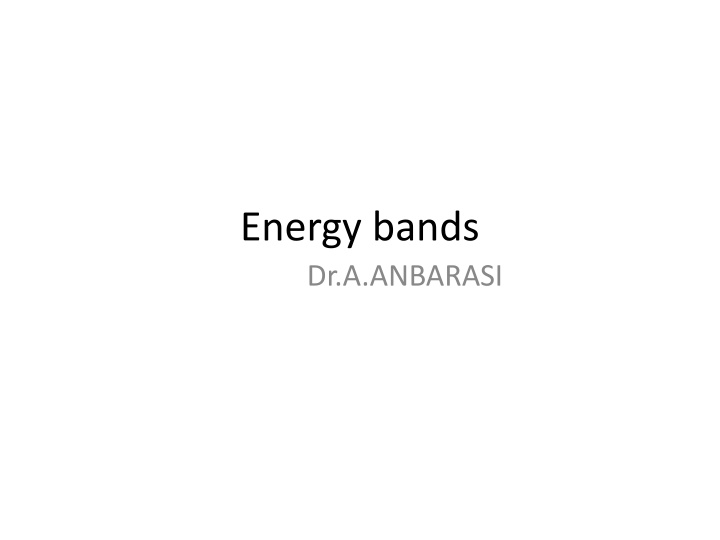
Energy Bands in Semiconductors and Insulators
Explore the concepts of energy bands, conduction bands, forbidden energy gaps, and characteristics of insulators and semiconductors. Learn about the differences in energy levels and conductivities in materials like silicon and germanium. Discover how these properties impact the behavior of electrons in different types of materials.
Download Presentation

Please find below an Image/Link to download the presentation.
The content on the website is provided AS IS for your information and personal use only. It may not be sold, licensed, or shared on other websites without obtaining consent from the author. If you encounter any issues during the download, it is possible that the publisher has removed the file from their server.
You are allowed to download the files provided on this website for personal or commercial use, subject to the condition that they are used lawfully. All files are the property of their respective owners.
The content on the website is provided AS IS for your information and personal use only. It may not be sold, licensed, or shared on other websites without obtaining consent from the author.
E N D
Presentation Transcript
Energy bands Dr.A.ANBARASI
Conduction band Conduction Band The valence electrons are so loosely attached to the nucleus that even at room temperature, few of the valence electrons leave the band to be free. These are called as free electrons as they tend to move towards the neighboring atoms. These free electrons are the ones which conduct the current in a conductor and hence called as Conduction Electrons. The band which contains conduction electrons is called as Conduction Band. The conduction band is the band having the lowest occupied energy
FORBIDDEN GAP Forbidden gap The gap between valence band and conduction band is called as forbidden energy gap. As the name implies, this band is the forbidden one without energy. Hence no electron stays in this band. The valence electrons, while going to the conduction band, pass through this. The forbidden energy gap if greater, means that the valence band electrons are tightly bound to the nucleus. Now, in order to push the electrons out of the valence band, some external energy is required, which would be equal to the forbidden energy gap. The following figure shows the valance band, conduction band, and the forbidden gap.
Characteristics of insulators Characteristics The following are the characteristics of Insulators. The Forbidden energy gap is very large. Valance band electrons are bound tightly to atoms. The value of forbidden energy gap for an insulator will be of 10eV. For some insulators, as the temperature increases, they might show some conduction. The resistivity of an insulator will be in the order of 107 ohm-meter.
Semi conductors Semiconductors Semiconductors are such materials in which the forbidden energy gap is small and the conduction takes place if some external energy is applied. Examples: Silicon, Germanium. The following figure shows the structure of energy bands in semiconductors.
Characteristics of semiconductors Characteristics The following are the characteristics of Semiconductors. The Forbidden energy gap is very small. The forbidden gap for Ge is 0.7eV whereas for Si is 1.1eV. A Semiconductor actually is neither an insulator, nor a good conductor. As the temperature increases, the conductivity of a semiconductor increases. The conductivity of a semiconductor will be in the order of 102 mho-meter.
Conductors Conductors are such materials in which the forbidden energy gap disappears as the valence band and conduction band become very close that they overlap. Examples: Copper, Aluminum. The following figure shows the structure of energy bands in conductors.
Characteristics of conductors Characteristics The following are the characteristics of Conductors. There exists no forbidden gap in a conductor. The valance band and the conduction band gets overlapped. The free electrons available for conduction are plenty. A slight increase in voltage, increases the conduction. There is no concept of hole formation, as a continuous flow of electrons contribute the current.
questions 1. what is insulator? 2. what is semiconductors? 3. what is conductors? 4. what is energy band? 5. what is energy gap? 6.what is fermi energy?



